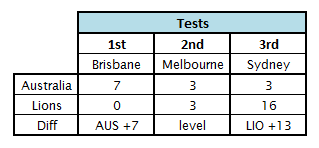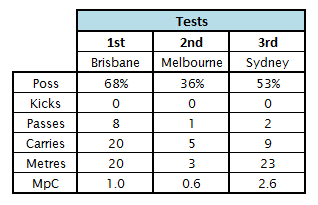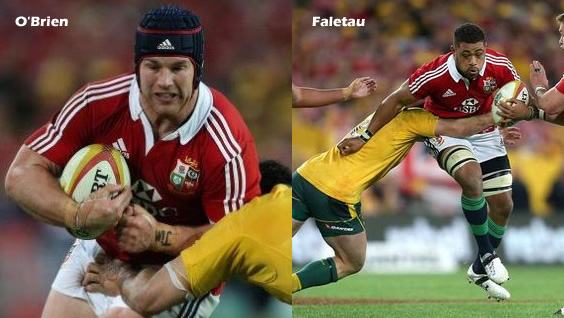As it’s most commonly associated (thanks to Dickens’ famous character Ebenezer Scrooge) with Christmas, the phrase ‘Bah! Humbug!’ might seem a little out of place in August, but as its general intention is to draw attention to the belief of delusion and/or deception, it seems appropriate to put it to use in reaction to most assessments of the 2013 Lions tour. After a week of high-pressure build-up, the Lions finished off their tour of Australia with a highpoint 41-16 win over the Wallabies at the Olympic stadium in Sydney. The 41 points were the most the Lions had ever scored in a Test and, predictably, provoked all sorts of sensational ‘scoreboard journalism’ praise: ‘Gatland’s finest hour, by a long chalk’ (Delme Parfitt, Western Mail) and ‘Triumph enhances Lions’ and Gatland’s reputations’ (Bryn Palmer, BBC) just a pair of examples which, in turn, helped provoke tGL’s own reaction: ‘Bah! Humbug!’
The final Test result was eye-catching – without doubt, and, in isolation, was bound to attract all manner of gushing superlatives; how could it not? The 25-point deficit meant it was the second biggest Test victory in Lions history, and also put the result among Australia’s biggest Test defeats on home soil. But, with the previous two Tests decided by a combined total of just three points, the Sydney result was not only a surprise to most, but most importantly it left a variety of unanswered questions – not least where that type of performance had been all along. As the best performance came at the final stage, it created an (unbalanced) parting memory because third-Test superlatives were too easily bundled together with over-positive general tour reviews that overlooked the real stories.
The third Test was a three-stage match: the Lions built an early 16-point lead on set-piece and forward pressure, the Wallabies kept the match in the balance by getting back to within three points at 19-16 just after half-time, and then the Lions’ backs moved up a couple of gears to add 19 points in the final 25 minutes and secure the Test and the series. The efficient manner the Lions built their lead early in the match and the relative ease with which they moved away in the final quarter simply begged the question: why exactly was the series so close before that? Why didn’t the Lions score good tries and accumulate 40 points against Australia in ALL the Tests?
Apart from one or two keen observers, the bright lights of the third-Test scoreline and the ‘Gatland’s vindication’ stories regarding Brian O’Driscoll’s non-selection drew attention away from the real issues the result raised. To answer those questions, we’re going to look at all three Tests, but as the Lions came closest to fulfilling their playing potential in the third Test, we’re going to apply the theory that this was ‘the right way to do it’ and look at what they didn’t do, in comparison, in the other Tests.
As it was the source of the platform on which the Lions built their third-Test victory, let’s start with a look at the opening quarters of the three Tests.
Match scores after 20 minutes
 In the first Test scrums were important in providing the Lions with 68% possession, but what did they do with it? They more or less kept the ball in hand in Australia’s half, kept the ball in close with pick-and-go or one/two-out carrying plays. Sometimes they tried to move it wider, but wherever they went they had trouble threatening the gainline. Credit to Australia’s defensive effort, but with direct-running centre Jamie Roberts out injured and Jamie Heaslip the only player in the pack anything like a recognised hard-ball carrier, maybe it wasn’t too much of a surprise that the carrying was largely unrewarded and produced just 35 metres from 37 carries.
In the first Test scrums were important in providing the Lions with 68% possession, but what did they do with it? They more or less kept the ball in hand in Australia’s half, kept the ball in close with pick-and-go or one/two-out carrying plays. Sometimes they tried to move it wider, but wherever they went they had trouble threatening the gainline. Credit to Australia’s defensive effort, but with direct-running centre Jamie Roberts out injured and Jamie Heaslip the only player in the pack anything like a recognised hard-ball carrier, maybe it wasn’t too much of a surprise that the carrying was largely unrewarded and produced just 35 metres from 37 carries.
The pack accounted for just over half that total (20), but in a game-sense it was low-impact possession for the Lions and the forwards didn’t exert any early dominance in that area of the match. Indeed, in the same period, an opportunistic counter-attack by Will Genia earned the Wallabies a try to make it 7-0 and only a couple of narrow penalty misses from James O’Connor before the try kept the scoreboard deficit down. The Lions’ pack not only failed to control the match with good possession, but they also shipped points against an opponent who had significantly less.
The unrewarded dominance was a consequence of the Lions’ own play and highlighted the necessity of balance between team composition and tactics. Before the tour tGL wrote about the difficult situation Warren Gatland created for himself with the selection of Sam Warburton as Lions captain and the opening 20 minutes of the first Test illustrated the point perfectly, as Gatland’s back row wasn’t properly equipped for getting over the gainline with the ball in hand and forcing Australia on to the back foot early on.
The tour-ending injury of prop Cian Healy – one of the best ball-carrying props in the northern hemisphere, should have ensured the first-Test back row had at least two noted gainline breakers in it, but with Warburton – more or less guaranteed his place in the side on captaincy grounds and a better player without the ball than with it, and Tom Croft – much better in open space than in heavy traffic, the specialist’s responsibility rested solely with Heaslip. Of 20 carries among the forwards, he made three, and for just two metres – little impact from the ‘go-to’ man.
If it’s your plan to keep possession among your forwards, you need to consistently threaten and get over the gainline to build and maintain forward momentum, so the decision to exclude noted carriers like Sean O’Brien and/or Toby Faletau from that first-Test team was very odd, and certainly hard to justify on the subsequent evidence of the carrying effectiveness of the alternatives. In addition, from a defensive point of view, O’Brien and Faletau are also both excellent stoppers, so their absences were doubly strange.
Notably, they were both in the starting XV for the third Test where, in the first quarter of the
match, 15% less possession produced fewer runs from the forwards, but in metres gained they were more than twice as effective. This figure was almost entirely down to Faletau and the Lions’ simple approach; they got the ball into the hands of their best ball carrier as often as they could and sent him into the opposition with support right behind him. The results were clear.
 Just over two-and-a-half metres per carry in the third Test shows that Australia were being forced back off the gainline, put under pressure and controlled in that opening period, and when forwards get dominant they’re tough to stop and that momentum moves into all facets of their game, as could be witnessed by the Lions’ scrum dominance. Both aspects of play undoubtedly fuelled each other and that was definitely reflected on the scoreboard as the Lions pushed into an almost easy 16-3 lead. So what was the big difference?
Just over two-and-a-half metres per carry in the third Test shows that Australia were being forced back off the gainline, put under pressure and controlled in that opening period, and when forwards get dominant they’re tough to stop and that momentum moves into all facets of their game, as could be witnessed by the Lions’ scrum dominance. Both aspects of play undoubtedly fuelled each other and that was definitely reflected on the scoreboard as the Lions pushed into an almost easy 16-3 lead. So what was the big difference?
Although slightly serendipitous (though it’s simply not nice to describe injury as such), finally, the strongest and best-balanced set of forwards were on the field, and only (in theory) Paul O’Connell would have added something that wasn’t there, despite Geoff Parling’s solid performance as the 2009 captain’s understudy. Richard Hibbard’s greater bulk (nearly 10cm and 10kg over Tom Youngs) and more refined technique was more than useful in the scrum, O’Brien was the strong manically-aggressive everywhere flanker that opposition teams have nightmares about containing, and Faletau was the dependably-menacing ball carrier that everyone knows he is.
It was written in many places that these players were unlucky not to be selected in a matchday squad before the final Test, but selection isn’t about luck, it’s a calculated decision, so when those players display, and display well, the abilities for which they are renowned and (presumably) were included in the original squad, it leads to the question of why exactly they weren’t involved up to that point. Unfortunately for Gatland, this quite simply goes back to his choice of captain for the tour, a choice which more or less stopped him picking his strongest and best-balanced back row from the beginning of the Test series. That is until Warburton’s hamstring made the decision for him in Melbourne.
Team balance and personnel are crucial, especially when considering the knock-on effect of selection on strategy and tactics, but Gatland gave the impression before and even during the series that he knew who he wanted to play, but didn’t know (or perhaps didn’t want to know) what his best team was. The Sydney performances of O’Brien and Faletau, and to a lesser degree Hibbard, showed Gatland’s previous selections were off. If he got it right in the end, great, but when the answer was clearly there all along, what’s the justification for not getting it right before?

